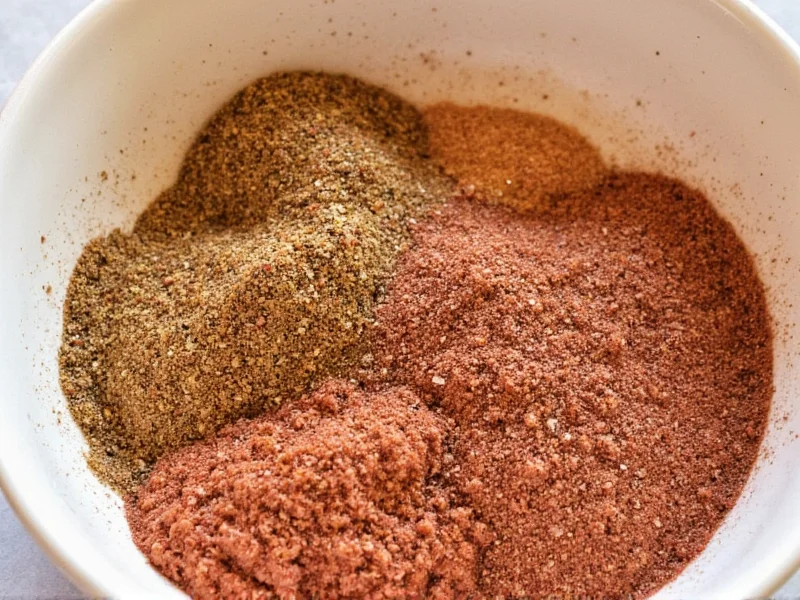A hamburger seasoning mix transforms ordinary ground beef into flavorful, restaurant-quality burgers with minimal effort. Unlike store-bought versions that often contain unnecessary fillers and anti-caking agents, a homemade blend lets you control ingredients and tailor flavors to your preference. The foundation of any effective mix combines salt for flavor enhancement, pepper for heat, and umami-rich powders like garlic and onion that complement beef's natural richness.
Essential Components of Quality Hamburger Seasoning
Understanding what makes a hamburger seasoning effective starts with recognizing its core components. Salt remains the most critical ingredient, not just for flavor but for modifying the meat's protein structure to retain moisture. Fine sea salt or kosher salt works best as they distribute evenly. Black pepper provides necessary heat and complexity, with freshly ground offering superior flavor. Garlic and onion powders deliver consistent savory notes without the moisture of fresh versions that could affect cooking.
Additional elements like paprika contribute color and subtle sweetness, while optional ingredients such as mustard powder or cayenne can add distinctive character. The key difference between professional-quality seasoning and commercial products lies in the absence of fillers like maltodextrin or silicon dioxide. Pure spice blends without these additives provide cleaner flavor and better browning during cooking.
Basic Homemade Hamburger Seasoning Recipe
This foundational recipe creates a versatile seasoning that enhances rather than masks beef's natural flavor. The proportions follow culinary best practices for meat seasoning while allowing room for customization.
| Ingredient | Measurement | Function |
|---|---|---|
| Kosher salt | 2 tablespoons | Flavor enhancement and moisture retention |
| Black pepper (freshly ground) | 1 tablespoon | Heat and complexity |
| Garlic powder | 1 tablespoon | Umami and savory notes |
| Onion powder | 1 tablespoon | Sweetness and depth |
| Paprika | 1 tablespoon | Color and subtle sweetness |
Mix all ingredients thoroughly in a bowl, then transfer to an airtight container. Store in a cool, dark place for up to six months. This basic blend follows the professional chef's guideline of seasoning ground beef at 1.5-2% of the meat's weight. For one pound of ground beef, use approximately 1½ teaspoons of this mix.
Advanced Customization Techniques
Once comfortable with the basic formula, customize your hamburger seasoning mix to create distinctive flavor profiles. Regional variations offer exciting possibilities while maintaining the essential balance that complements beef.
Southwest Style Burger Seasoning
Add 1 teaspoon each of cumin and chili powder plus ½ teaspoon cayenne to the basic recipe. This combination creates a warm, earthy profile that pairs well with melted pepper jack cheese and avocado toppings.
Umami-Boosted Gourmet Blend
Incorporate 1 teaspoon mushroom powder (made from dried porcini mushrooms) and ½ teaspoon celery seed into the basic mix. The additional umami compounds deepen the meaty flavor without overpowering the beef.
Smoke-Infused Variation
Replace regular paprika with smoked paprika and add ½ teaspoon liquid smoke powder. This creates a campfire-like quality that mimics grilled flavors even when cooking indoors.
Proper Usage Techniques for Maximum Flavor
How you apply seasoning significantly impacts the final burger's taste and texture. Follow these professional techniques for optimal results:
- Season before forming patties: Distribute seasoning evenly throughout the meat before shaping. This ensures consistent flavor rather than just surface seasoning.
- Avoid overmixing: Gently fold seasoning into meat just until incorporated. Excessive handling compacts the meat, resulting in dense, tough burgers.
- Create a thumb indentation: After forming patties, press a shallow dimple in the center. This prevents bulging during cooking as the meat contracts.
- Don't season too early: For best results, season immediately before cooking. Extended contact between salt and raw meat can begin breaking down proteins excessively.
Common Hamburger Seasoning Mistakes to Avoid
Even experienced cooks make these critical errors that compromise burger quality:
- Using old spices: Dried spices lose potency after 6-12 months. Test garlic powder by rubbing a small amount between fingers - if you don't detect strong aroma, replace it.
- Adding liquid ingredients to dry mix: Never include Worcestershire sauce or other liquids in your dry seasoning blend. These cause spoilage and prevent proper storage.
- Over-seasoning: More isn't better. Excessive salt draws out moisture, creating steam that prevents proper searing and leads to gray, boiled-looking meat.
- Ignoring meat quality: No seasoning can compensate for poor-quality ground beef. Start with at least 80% lean meat for optimal fat content that carries flavor.
Storage and Freshness Guidelines
Proper storage maintains your homemade hamburger seasoning mix's potency and safety. Transfer the blend to an airtight glass or metal container immediately after preparation - plastic containers can absorb odors and may leach chemicals. Store in a cool, dark cupboard away from heat sources like your stove or dishwasher.
Check your seasoning mix periodically for freshness. Properly stored, it should remain potent for 6 months. Signs of degradation include faded color, diminished aroma, or clumping (which indicates moisture exposure). Never store seasoning mixes in the refrigerator, as temperature fluctuations introduce condensation that accelerates spoilage.











 浙公网安备
33010002000092号
浙公网安备
33010002000092号 浙B2-20120091-4
浙B2-20120091-4